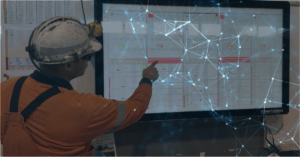AI and Machine Learning in Mining: Why Granular Data Matters
In recent years, one of the most discussed topics in mining has been the application of Artificial Intelligence (AI) and Machine Learning (ML) to revolutionise the industry. Many discuss the importance of data in this transition, but few recognise the required granularity to support it.
Since 2010, miners have invested in ERP (finance and asset management), mine planning and FMS (with autonomous capabilities). With planning and real-time data capture covered, a critical gap remains in integrating operational planning and execution data.
The importance and impact of this data, still commonly managed using whiteboards, PowerPoint, Excel or paper, has become increasingly clear.
Mining Activity Conformance to Plan (CtoP) and Its Limitations
Conformance to Plan (CtoP) applied to Mining Activities often excludes enabling or development activities essential for success. Traditional CtoP reporting highlights issues but lacks context. Operations apply insufficient rigour to managing enabling tasks as is required for effective collaborative planning. For AI/ML solutions to suggest improvements, they require deeper, more granular insight than what traditional short-term mine planning tools offer.
A mine plan optimistically lists key tasks to be completed, and once reviewed with all parties establishes a baseline of critical path items forming the measurable data set for KPIs. However, KPIs and plan variances are diagnostic, not actionable. Action requires supporting data that exposes contributing factors and enables tasks to be scheduled, assigned, executed, and evaluated.
Expanding the Mine Plan to Capture All Mining Activities
The plan must expand to include all work ensuring delivery of critical path items and recognise the impact of all processes on the schedule. Many sites do not complete this scheduling work, assuming other teams will complete tasks. Without considering all tasks, it is impossible to understand the true resourcing required. Capturing this information on whiteboards, spreadsheets or paper doesn’t allow for future analysis, especially by AI tools needing a data warehouse for ML analysis.
Data that represents progress to plan must be captured. In mining, many critical path items can be updated from third-party tools like FMS. Capturing enabling task progress is complex and requires an IT solution. Compiling these inputs from varying sources into a data lakehouse will provide a platform for rules-based and ML analysis. ML can then detect data trends useful for generative, predictive or agentic AI, supporting real-time schedule optimisation.
Integrating Systems to Unlock Real-Time AI in Mining
AI will continue to impact how we view plans and their execution. The key is ensuring all relevant data is captured and connected so ML can identify useful trends, highlight opportunities and reveal issues early.
To support effective reporting and analytics, data must be captured, and relationships established in real-time for rapid decision making. Integrating ERP and FMS with operational execution data will provide richness to power advanced AI/ML.
Capturing Critical Execution Data with CiteOps
CiteOps is an integrated planning and execution software solution. Designed to capture short range plans and plans and executional activities while fostering continuous feedback loops, this solution greatly improves productivity.
This enterprise-grade operational planning and execution platform designed specifically for mining and metals companies enables:
- Unified planning and execution
- Dynamic scheduling
- Centralised resource management
- Real-time decision making and
- Mobile execution





